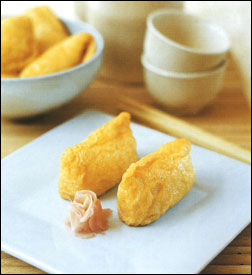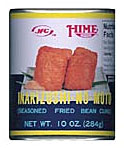
![]()
Kitsune-zushi, Inari-zushi
Fox Sushi
 |
|
|
|
Japan was—and according to some people, still is—filled with fox spirits, mischievous and lascivious creatures that take the place of fairies, poltergeists, and succubi in Japan. The more virtuous of them join the court of Inari, the god/goddess of the rice harvest, and become his/her messengers. On certain holidays, worshippers travel to Inari's shrines and offer the multitude of statues of foxes plates of thin slices of fried tofu stuffed with rice, their favorite food, to honor and to placate them.
One would expect such sophisticated and dangerous creatures to demand an equally sophisticated dish, but fried tofu stuffed with rice—kitsune-zushi, "fox sushi," or Inari-zushi, "Inari sushi"—is one of the simplest sushis out there. Lightly sweet, vegetarian, and fully cooked, it's excellent for long trips, and it's so simple to make that even beginner sushi chefs find it a breeze.
Ingredients
2 or 3 cups of plain, steamed white rice
A can of Inarizushi-no-moto (little pita pockets of fried tofu canned
in mirin syrup. Some versions come canned in soy sauce, but the final
taste is much different from this recipe.)
Directions
- Get the Inarizushi-no-moto out of the can. This is a major pain in
the tuckus until you've gotten the first couple of pieces out. As you
take each piece out, try to get as much syrup off as possible. If you
tear a piece, you now face a terrible decision: Keep it and make it
into sushi despite its crippling flaw, or eat it as is?
- Mix some of the syrup in with the rice—enough to flavor the rice,
but not enough to cause the rice to completely fall apart. Add a dash
of soy sauce if you want a less emphatically sweet flavor.
- Open an Inarizushi-no-moto carefully. Wet your hands so the rice won't
stick, then pick up some rice, pat it into a ball, and stuff the Inarizushi-no-moto.
You might want to start with a small ball and add more once the first
rice is in the pocket. The rice should be packed firmly, but not hard;
according to one sushi
aficionado, a perfectly packed ball of sushi rice offers "the
pleasant sensation of gently expanding in the mouth." Fill the
pocket with a little room to spare at the top so that you can close
the pocket.
- Fold the edges of the pocket over one another and place the completed
kitsune-zushi on a tray opening-down so that the pocket stays closed.
- When you're done making kitsune-zushi, you can drizzle a little of the remaining syrup over the plate or scatter a few toasted sesame seeds.
There are plenty of variations on this recipe. You can mix toasted sesame seeds in with the rice, arrange the pocket open-end-up, etc. Instead of mixing the syrup in with the rice, you can make your own sauce with mirin and soy sauce. Other cookbooks have recipes for non-sweet kitsune-zushi, which are made in the same way but use Inarizushi-no-moto canned with soy sauce.
Uncommon Ingredients
 |
Inarizushi-no-moto
canned in mirin syrup |